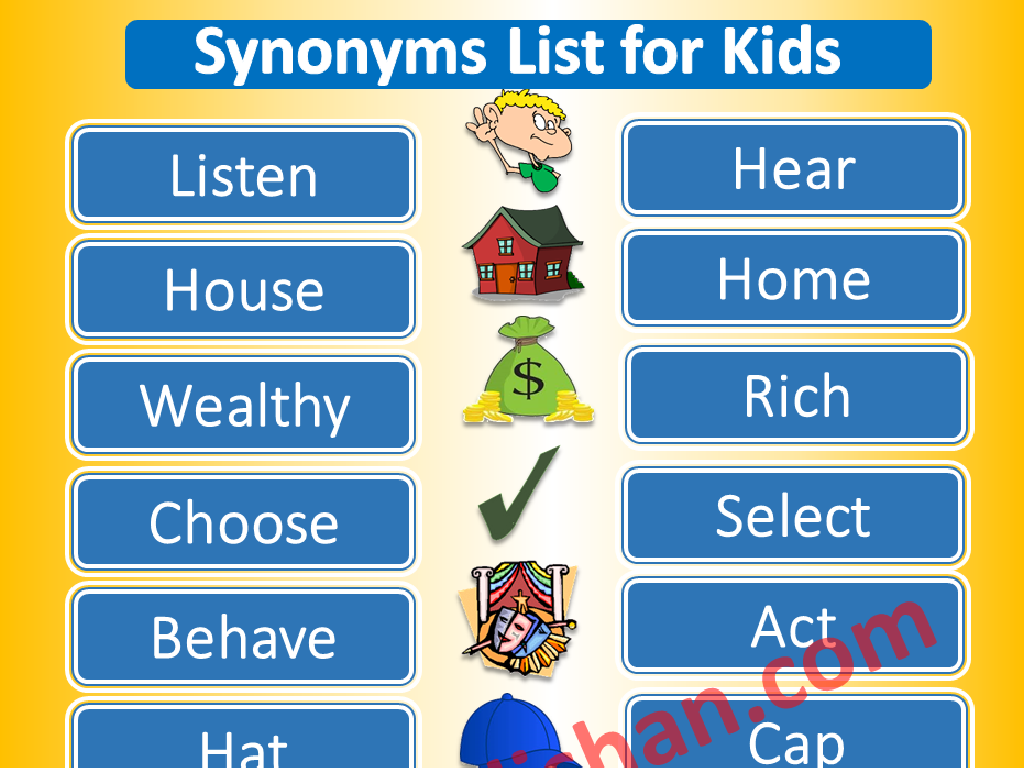Determine The Meaning Of Idioms From Context: Set 2
Subject: Language arts
Grade: Fourth grade
Topic: Idioms And Adages
Please LOG IN to download the presentation. Access is available to registered users only.
View More Content
Introduction to Idioms
– What exactly are Idioms?
– Phrases with a meaning different from the literal words
– The purpose of using Idioms
– To express ideas in a creative way
– Everyday Idioms examples
– ‘Piece of cake’ means something very easy
– Understanding Idioms in context
– Use surrounding text to figure out idiom meanings
|
This slide introduces the concept of idioms to fourth-grade students, explaining that idioms are phrases where the words together have a different meaning than the dictionary definitions of the individual words. Emphasize that idioms add color and expressiveness to our language, making communication more engaging. Provide relatable examples like ‘piece of cake’ to illustrate how common idioms are in everyday language. Encourage students to think of idioms as a secret code that they can learn to understand by looking at the context in which they’re used. In the next class, we can have students bring in examples of idioms they find in their favorite books or shows.
Understanding Idioms: More Than Just Words
– Idioms: Not literal phrases
– Phrases where the whole meaning is different from the individual words, like ‘piece of cake’ means something very easy.
– Understanding beyond words
– Idioms make language colorful
– They add fun and emotion to how we communicate, like saying ‘it’s raining cats and dogs’ when it’s pouring rain.
– Examples in everyday language
– We use idioms often without noticing, such as ‘break a leg’ to wish someone good luck.
|
This slide introduces students to the concept of idioms, emphasizing that their meanings cannot be deduced from the literal interpretation of the words they contain. Explain that idioms are a way to add flavor to our language, making it more vivid and expressive. Provide examples of idioms that they might hear in everyday conversation, and explain the actual meanings behind these phrases. Encourage students to think of idioms they have heard and share them with the class. This will help them understand that idioms are a common and fun part of language arts.
Understanding Idioms: Set 2
– ‘Break the ice’ meaning
– To initiate conversation in a social event
– ‘Piece of cake’ explained
– Refers to a task that is very easy to complete
– ‘Let the cat out of the bag’
– To accidentally reveal a secret or surprise
– Practice using idioms
|
This slide introduces students to the concept of idioms phrases that don’t mean exactly what the words say. ‘Break the ice’ is used when someone does something to create a more friendly and relaxed atmosphere. ‘Piece of cake’ is a fun way to say that something is very easy to do, without any difficulty. ‘Let the cat out of the bag’ means to reveal a secret, usually without intending to. Encourage students to think of times when they have heard these expressions or when they could use them. For practice, students can create sentences using these idioms or even come up with a short story that includes all three. This will help them remember the idioms and understand how to use them in context.
Understanding Idioms in Stories
– Read a story with idioms
– Find a story that includes common idioms
– Spot the idioms used
– Look for phrases that don’t make literal sense
– Discuss each idiom’s meaning
– Explain what the idioms mean in the story
– Contextual understanding of idioms
– How the surrounding text gives clues to the idioms’ meanings
|
This slide is aimed at helping students understand idioms through the context provided by a story. Begin by reading a story that contains several idioms. Encourage students to identify idioms, which are phrases that cannot be understood from the literal meanings of the words. After identifying the idioms, lead a discussion on what each idiom means within the context of the story. Explain that the meaning of an idiom is often different from the direct interpretation of the individual words. Use examples from the story to show how the context helps us infer the meaning of each idiom. This exercise will enhance students’ comprehension skills and their ability to interpret figurative language.
Practice with Idioms: Set 2
– Fill in the blank with the right idiom
– Use context clues to choose an idiom that fits the sentence
– Match idioms to their meanings
– Connect each idiom to its correct meaning
– Create sentences with idioms
– Write original sentences using different idioms
– Understand idioms in context
– Learn how idioms paint pictures with words
|
This slide is designed for a class activity focused on idioms. Students will practice by filling in blanks in sentences with appropriate idioms, ensuring they understand the idiom’s meaning within the context. Next, they will match a list of idioms to their meanings, reinforcing their comprehension. Then, students will create their own sentences using idioms, which encourages them to think creatively and apply their knowledge. Finally, discuss how idioms can create vivid images and convey meanings in a fun and engaging way. For the teacher: Prepare a worksheet with sentences and a list of idioms for the fill-in-the-blank activity. Have a matching exercise ready with idioms and definitions. Provide examples of idioms used in sentences to guide students in creating their own. Encourage students to share their sentences and explain the idioms they chose.
Class Activity: Idiom Charades
– Play charades with idioms
– Act out an idiom silently
– Use body language to convey the idiom’s meaning
– Classmates guess the idiom
– Think about the idiom and what actions might show its meaning
– No speaking allowed!
|
This activity is designed to help students understand idioms through a fun and interactive game of charades. Each student will have a turn to act out a common idiom without using any words while their classmates try to guess the idiom based on the actions performed. Teachers should prepare a list of idioms suitable for the fourth-grade level. Possible idioms for the activity could include ‘a piece of cake’, ‘let the cat out of the bag’, ‘hit the nail on the head’, and ‘break the ice’. Teachers should encourage students to think creatively about how to express the meaning of the idiom through actions. This activity will enhance students’ ability to infer meaning from context and improve their understanding of idiomatic expressions.
Wrapping Up Idioms & Homework Task
– Review today’s idioms
– Recap the meanings of idioms discussed in class
– Why idioms matter
– Idioms add color to language and express ideas vividly
– Homework: Craft a story
– Write a creative short story incorporating idioms
– Use 5 idioms in your story
– Ensure the idioms fit naturally into your story’s context
|
As we conclude today’s lesson on idioms, remind students of the idiomatic expressions they’ve learned and their meanings. Emphasize the importance of idioms in making language more expressive and engaging. For homework, students are tasked with writing a short story that includes at least five of the idioms discussed. This will help them understand how idioms can be used in context. Encourage creativity and remind them that the goal is to use idioms in a way that makes sense within the story’s narrative. Offer examples of stories that effectively use idioms and provide a list of the idioms covered in class for reference.






